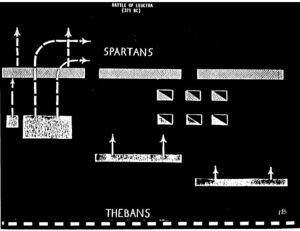Patterns of Conflict
| The works of |
| Works of John Boyd |
|---|
OODA WIKI Edition
Quantico Transcription
Then we see the battle of Leuctra, where we have the Spartans on top here, and the Thebans making the attack under their
commander Epamonidas. In fact, they were outnumbered almost two to one. But note what he did, he thinned out his center and right wing, refused them or pulled them back, put the stronger troops in here, so at the point of contact he had strength against weakness. In other words the guy was weaker than he was, even though they had more troops. And of course [unintelligible] stretched out, and it’s a single envelopment scheme.
In fact, how many people have read Liddell Hart’s book, Strategy?[1] I don’t necessarily recommend it too highly, but one of the things he said was that this was a good example of the oblique order, he called it oblique order, you want to keep that in mind. Well, you can’t think that schematic anymore, that doesn’t do it. But there is a good idea in it, if you think about it correctly.
Lightfoot Transcription
- ↑ 12 B. H. Liddell Hart, ''Strategy,'' 2nd ed. (New York, NY: Meridian, 1991). Hart was a British infantry officer in World War I. His experiences in the trenches of the western front influenced his later writings on military theory, where he explored methods for victory that did not require bloody frontal assaults. ''Strategy'' discussed this “indirect approach,” which Hart refined throughout his writings in his lifetime.
